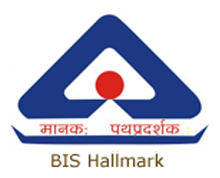GOLD KARATAGE
Karatage is an indication of gold content. The gold-quality system consists of 24 parts, or karats. Pure gold is called 24 karat (marked as 24k, 24kt, or 999). That means that 24 out of 24 parts of the metal are pure gold: 99.9% pure gold. The Karat of gold, is not to be confused with carat weight of stones or diamonds. IT refers here to the purity of gold used therein.
You can alter the karatage of gold by adding other metals. To increase a gold's karat, you would add pure fine gold. To lower a gold's karat, you would add alloy mix.
When purchasing an item of Gold, always look for a Karat mark which should be stamped on it. This is the quality mark and refers to the proportion of pure gold used in the item. Pure Gold, which is 24kt, is generally too soft to be used in Jewelry and hence is alloyed with other precious metals to increase it’s durability. Some of the common marks found on Jewelry, with their metric equivalents are:
22kt - 916
21kt - 875
18kt - 750
14kt - 585
9kt - 375.
Hallmarking of Jewellery
BIS CERTIFICATION SCHEME FOR HALLMARKING OF GOLD JEWELLLERY
Government of India' has identified BIS a sole agency in India to operate this scheme. BIS hallmarking Scheme is voluntary in nature and is operating under BIS Act, Rules and Regulations. It operates on the basis of trust and thus it is desirable that aspect of quality control are in built in the system responsible for managing quality.
The BIS Hallmarking Scheme has been aligned with International criteria on hallmarking (Vienna Convention 1972). As per this scheme, licence is granted to the jewellers by BIS under Hallmarking Scheme. The BIS certified jewellers can get their jewellery hallmarked from any of the BIS recognized Assaying and Hallmarking Centre. The recognition to an Assaying and Hallmarking Centre is given against BIS criteria which is in line with International criteria on Marking and Control of Precious metals.
Design of Hallmark on Gold Jewellery

HALLMARKING CERTIFICATION OF GOLD

Government of India understood the necessity of protecting the public in its purchases of gold jewellery specially with regard to standards of fineness and the prevention of adulteration, be it deliberate or accidental. The principle objectives of the Hallmarking Scheme are to protect the public against the fraud of adulteration and to oblige manufacturers to maintain legal standards of fineness.
Hallmarking is the accurate determination and official recording of the proportionate content of precious metal in gold. Hallmarks are thus official marks used in many countries as a guarantee of purity or fineness of gold jewellery.
Taking cognizance of these aspects the RBI Standing Committee on Gold and Precious Metals opined that introduction of a Hallmarking System would not only protect the public from fraud, but also assist exports of jewellery. While agreeing on this the Committee reckoned that compulsory certification of gold would not be implementable on account of the massive structure of trade. Recommending the pursuance of a voluntary scheme, it emphasized the deviations in purity of fine metal should invoke penalties under legislation and BIS was named as the sole agency in the country for Hallmarking of gold jewellery under the provisions of the BIS Act, 1986.
The hallmark
BIS hallmark for gold jewellery consists of several components:
- The BIS logo
- A three digit number (out of a set of six pre-defined values) indicating the purity of the gold in part-per-thousand-format viz; 958, 916, 875, 750, 585, 375. Thus a BIS 916 hallmark would certify to a purity of 916 per 1000, that is 91.6%, translating to a 22 carat purity of gold.
- Logo of the assaying centre
- A code denoting the date of hallmarking
- Logo/code of the jeweller
